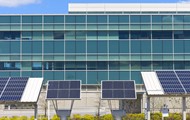 Net Zero Cheshire
Net Zero Cheshire
The first step on the road towards decarbonising the energy usage of a building should be to understand the pattern and quantity of energy used by it and its occupants before any alteration are made.
This is well worth the time and effort. Only by understanding the ‘energy profile’ – what energy demand and generation there is, what it is used for and when – can any strategic investments made to decarbonise the building bring maximum benefits. Understanding current energy usage will inform which options for improving energy efficiency, electricity generation and storage, heating systems, and heat generation and storage are best matched to a particular building. This could be based on the type of building, its geographical situation, what sources of energy are used, how much, and when, and what future plans there are for the business that uses the building.
The COVID-19 pandemic has resulted in a seismic change in working practices – where we work, how we use technology, whether meetings, conferences and training courses need to be held face-to-face or whether it is just as productive to hold them online. None of us know the extent to which, once the pandemic recedes work practises will return to pre-pandemic routines, however it seems unlikely that the 2019 status quo will return. It is therefore worth considering the impact of the changing work practises brought about by the pandemic will have on your building before you make any investment decision.
Keep in mind the answers to the following questions when reading about different improvement options available.
What is the primary use of the building?
- For example, is it an office, shop, or warehouse? This will impact how much of your energy is used and what for. Different building types will use different proportions of electricity for lighting, computer servers, and refrigeration, and different proportions of energy for space heating, hot water, process heating, and cooking.
How big is the building? Is it spread over a large area? How many stories does it have?
- This will affect how much wall and roof space there is for heat to escape from.
What is the building’s internal layout? Is it mostly open plan, or does it comprise of a large number of moderately sized rooms/offices?
- This will affect how heat travels through the building.
Where is the building? What is around it in terms of other companies and geographical features?
- Pole-mounted wind turbines standing next to a tall building or solar panels in the shade of trees, for instance, are clearly not worthwhile investments. Nearby companies may bring opportunities to collaborate, for example a hydroelectric system in a nearby river could be jointly paid for and benefitted from, where one company alone may not be willing or able to invest enough.
Who owns the building? What is its lease length? Are there any stipulations in the lease about building improvements?
- If the building is rented, then the landlord may stipulate that tenants cannot make material changes to the building or that approval must be sought from them before changes are made. It is important also to clarify the future ownership and liabilities after installing these technologies. For instance, who benefits from any income from future energy generation requires agreement. An important consideration here is how certain it is that the company will remain in the current building for an extended period of time.
Does the building have a car park? How many spaces? Is it immediately adjacent to the building, or separated?
- The feasibility of installing charging points may decrease if the car park is not close to the building and extensive cabling requires laying. The car park may have potential for generating technologies, like solar panels on a carport, a wind turbine, or a heat pump underneath it.
Is there any additional land with the building? What is it used for?
- If this land could be repurposed, or even have another use alongside its current one, it may be suitable for installing solar panels, wind turbines, a heat pump, battery storage, biomass fuel storage, solar thermal panels, or a thermal store on.
What process in the building uses the most electricity? The most heating fuel?
- Investigate ways in which these processes can be made more efficient or their fuel source can be switched to a low carbon source; changes to these processes could make significant progress towards decarbonisation of the building.
What does the building’s Energy Performance Certificate (EPC) say?
- This may have recommendations for improving energy performance that are worth considering.
How often is the building occupied? By how many people? For which hours of the day? How does energy consumption change when the building is occupied/unoccupied? How does energy consumption change at night?
- If there is not much change in the building occupancy at night then generation during the day, for example solar panels or solar water heating, might not be as suitable as generation that can happen equally well at night, like wind turbines, hydroelectric, or heat pumps. Equally, if the building is not occupied during the night then daylight only generation may be more applicable, unless energy storage mediums are being considered also.
How does energy consumption change at weekends?
- If energy use if much lower over weekends it could be beneficial to have battery storage or a thermal store and generating technologies to ‘charge up’ the storage over the weekend ready for Monday.
How does energy consumption change seasonally?
- If winter heating demand is much higher than summer, then a large thermal store may be especially suitable, storing warmer water from the summer. If winter electricity demand is much higher than summer, then wind turbines or hydroelectric generation may be especially suitable as these are more effective in winter than summer. If there is a high cooling demand in summer, then an air-to-air heat pump may be especially suitable, as it can circulate cool air as well as providing heating.
Is the building shut down for a portion of the year, for example over Christmas, the summer, or the winter?
- Any summer shut down will harm the business case for solar water heating, solar panels, or an air-to-air heat pump. Any winter shut down will harm the business case for a thermal store, wind turbines, or hydroelectricity.
When is the maximum energy demand of the building during normally expected operation (usually mid-Winter)? The minimum energy demand during normal operation (usually mid-Summer)?
- It is important to quantify how much of the building’s maximum energy demand might it be able to be self-generate and how much the building might export when energy demand is lowest. The case for energy storage to save emissions or money, by storing up for times of maximum demand to ‘smooth’ the demand peak or by storing energy for self-consumption later instead of exporting is dependent on this data, as well as the building’s energy ‘base load’. (The base load being the amount of energy used when the building is empty, and everything that can be switched off has been.)
How much does the building user spend on energy bills?
- If you can, compare the amount of energy used by your building and cost with that of similar buildings or businesses in similar markets. If your usage is comparatively high, consider prioritising energy efficiency measures.
Is expenditure on energy high relative to other operational costs?
- If energy expenditure is proportionally high compared to other costs, then cost saving may be a more significant motivation and this should be considered when choosing a path.
How has that expenditure changed over time?
- This could be the impact of energy efficiency measures already implemented. If so, consider what was done, why, and if any thought was given to next steps. Or was the reduction caused by changes in business activity? Consider if the use of certain energy-intensive processes will be required again in the future, and if so whether they be made more energy or carbon efficient.
Who is the building’s energy provider?
- Some energy providers offer low or zero carbon tariffs, as well as tariffs tailored to customers with solar panels or electric vehicle charging points.
What kind of energy tariff is the building on?
- It may be advisable to find out if the contract fixed term, and if so when can you change either your energy supplier or tariff. Consider whether the potential savings could be achieved by switching energy provider or switching to a tariff such as a low or zero carbon electricity tariff.
Special tariffs are available tailored for electricity exports, solar generation, electric vehicle charging, storage, demand-side response, and more that should be investigated if applicable.
Is the building connected to the electricity or natural gas grids?
- If you are off the electricity grid your building is probably already self-generating. If this is not from a low carbon, renewable generation source, this can be considered, and the building can have its electricity use optimised, using as much of the electricity generated as possible. The building may be a strong contender for considering battery storage. If the building is off the gas network, consider the cost and carbon intensity of the heating solution installed with more emphasis.
Does the building use another kind of fuel such as oil, LPG (liquid petroleum gas), or biomass?
- If the building is not on the gas network, consider if a back-up heating system is required.
Is there any renewable energy generated on site? If so, how?
- If there is already renewable generation on site, consider optimising your use of it, for example by investing in battery storage. Potentially increasing the amount of generated energy used by the building can increase return on investment, so it may be beneficial to consider this.
Are there any means of controlling energy demand or generation?
- If not, consider smart heating controls or a building energy management system. If the building already has renewable generation, consider upgrading their control systems or integrating into a whole building energy management system.
Is there any energy storage on site?
- Whether it is electrical or thermal energy storage consider whether its performance has been optimised and how energy demands match any on site generation at different times of day and year.
Is any energy exported, e.g., electricity back to the grid?
- If energy is exported, consider whether it would be more financially beneficial to store excess energy for self-consumption, or vary the times at which energy is consumed for certain processes.
How vital is security of energy supply to what happens in the building?
- The business case for investing in energy storage and generation (with ‘black start’ capability) could be improved if this is the case.
Does the building have any back up energy supply or generators?
- Research whether generators be switched to a lower carbon fuel, for example from diesel or oil to biomass or hydrogen.
Are there any plans to reconfigure or extend the building?
- Any building work should maximise energy efficiency. Some technologies such as thermal stores, underfloor heating, and heat pumps are much cheaper to incorporate in new builds or extensions than retrofits, so should be considered at the planning stage.
Are there any plans considering relocation?
- If so, this may shorten the payback terms of any technology, making the investment less worthwhile from a monetary perspective.

